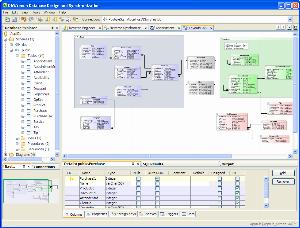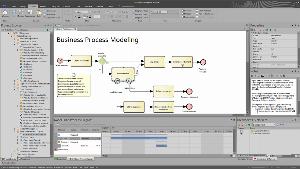GUI tools for MySQL
Graphical user interface (GUI) tools consist of an interface that includes visual components such as buttons or icons, through which the user interacts with electronic devices. The biggest advantage of graphical user interface is an improvement in usability for the average person. It gives the ability to perform various tasks on an electronic device, without any programming knowledge.
DatabaseSpy
Altova DatabaseSpy is the unique multi-database query and design tool. The DatabaseSpy graphical Design Editor lets you view and edit the structures of all your databases through one graphical user interface. You can examine tables and relationships in an existing database, edit tables to better suit your needs, or even can add entire tables and specify all their column attributes and relationships to other tables from scratch.
| Desktop/Cloud: | Desktop |
|---|---|
| Free edition: |
|
| Schema design: |
|
| Commercial: | Commercial |
| Forward engineering: |
|
| Reverse enginering: |
|
DbWrench
DbWrench is a database design and synchronization tool that makes creating and modifying databases quicker and easier. You can use ER diagrams to model, analyze, and communicate your designs and reverse engineer databases into our database designer in seconds.
| Desktop/Cloud: | Desktop |
|---|---|
| Free edition: |
|
| Schema design: |
|
| Commercial: | Commercial |
| Forward engineering: |
|
| Reverse enginering: |
|
Enterprise Architect
Enterprise Architect is a visual modeling and design tool based on the OMG UML. As a multi-user graphical tool, it is designed to help enterprises built logical and physical data models. It helps individuals, groups, and large organizations to model and manage complex information effectively.
| Desktop/Cloud: | Desktop |
|---|---|
| Free edition: |
|
| Schema design: |
|
| Commercial: | Commercial |
| Forward engineering: |
|
| Reverse enginering: |
|
ModelSphere
Open ModelSphere is a powerful tool for business process, data, and UML modeling. It is a complete data modeling tool, that covers conceptual and logical data modeling as well as physical design, i.e., database modeling (database modeling). It supports several notations, e.g., Entity-Relationship, DATARUN, and Information Engineering. Conceptual models can be converted to relational models and vice versa.
| Desktop/Cloud: | Desktop |
|---|---|
| Free edition: |
|
| Schema design: |
|
| Commercial: | Free |
| Forward engineering: |
|
| Reverse enginering: |
|
erwin Data Modeler
erwin Data Modeler (erwin DM) is a data modeling tool used to find, visualize, design, deploy, and standardize high-quality enterprise data assets. It also automates and standardizes model design tasks, including complex queries, to improve business alignment, ensure data integrity and simplify integration.
| Desktop/Cloud: | Desktop |
|---|---|
| Free edition: |
|
| Schema design: |
|
| Commercial: | Commercial |
| Forward engineering: |
|
| Reverse enginering: |
|
dModelAid
dModelAid is the perfect modeling tool for documenting a complex database design in a simple, interactive diagram. You can clearly visualize model objects supporting EER and three data modeling phases. In addition, you can quickly find any object or properties with the search function
| Desktop/Cloud: | Cloud |
|---|---|
| Free edition: |
|
| Schema design: |
|
| Commercial: | Commercial |
| Forward engineering: |
|
| Reverse enginering: |
|
Vertabelo
Vertabelo is a database modeler that gives you the power of visual design of databases online. It provides the perfect UI to create databases quickly and easily manage tables, views, references, etc.
| Desktop/Cloud: | Cloud |
|---|---|
| Free edition: |
|
| Schema design: |
|
| Commercial: | Commercial |
| Forward engineering: |
|
| Reverse enginering: |
|
Model Xtractor
Model Xtractor is a software utility designed to inspect modeling for traditional or enhanced ER models, with support for most relational database platforms. It lets you hide, collapse, or minify table/view shapes. Bypass intersection tables and show conceptual many-to-many connectors between shapes.
| Desktop/Cloud: | Desktop |
|---|---|
| Free edition: |
|
| Schema design: |
|
| Commercial: | Commercial |
| Forward engineering: |
|
| Reverse enginering: |
|
The key feature of GUI tools is to present system resources, in graphical objects, that are easy to find, understand and use. Through these elements users have an easy access to interact with and manipulate available functions. They allow us to speed up the most frequent tasks in the easiest and most accessible way.
We prepared simple data modeling tools as well as more advanced GUI tools for visually designing and managing databases.
 SQL Server
SQL Server
 Oracle
Oracle
 MySQL
MySQL
 PostgreSQL
PostgreSQL
 Amazon Redshift
Amazon Redshift
 Azure SQL Database
Azure SQL Database
 DBT
DBT
 Google Big Query
Google Big Query
 IBM DB2
IBM DB2
 MariaDB
MariaDB
 SAP HANA
SAP HANA
 Snowflake
Snowflake
 SQLite
SQLite
 Teradata
Teradata
 Vertica
Vertica















